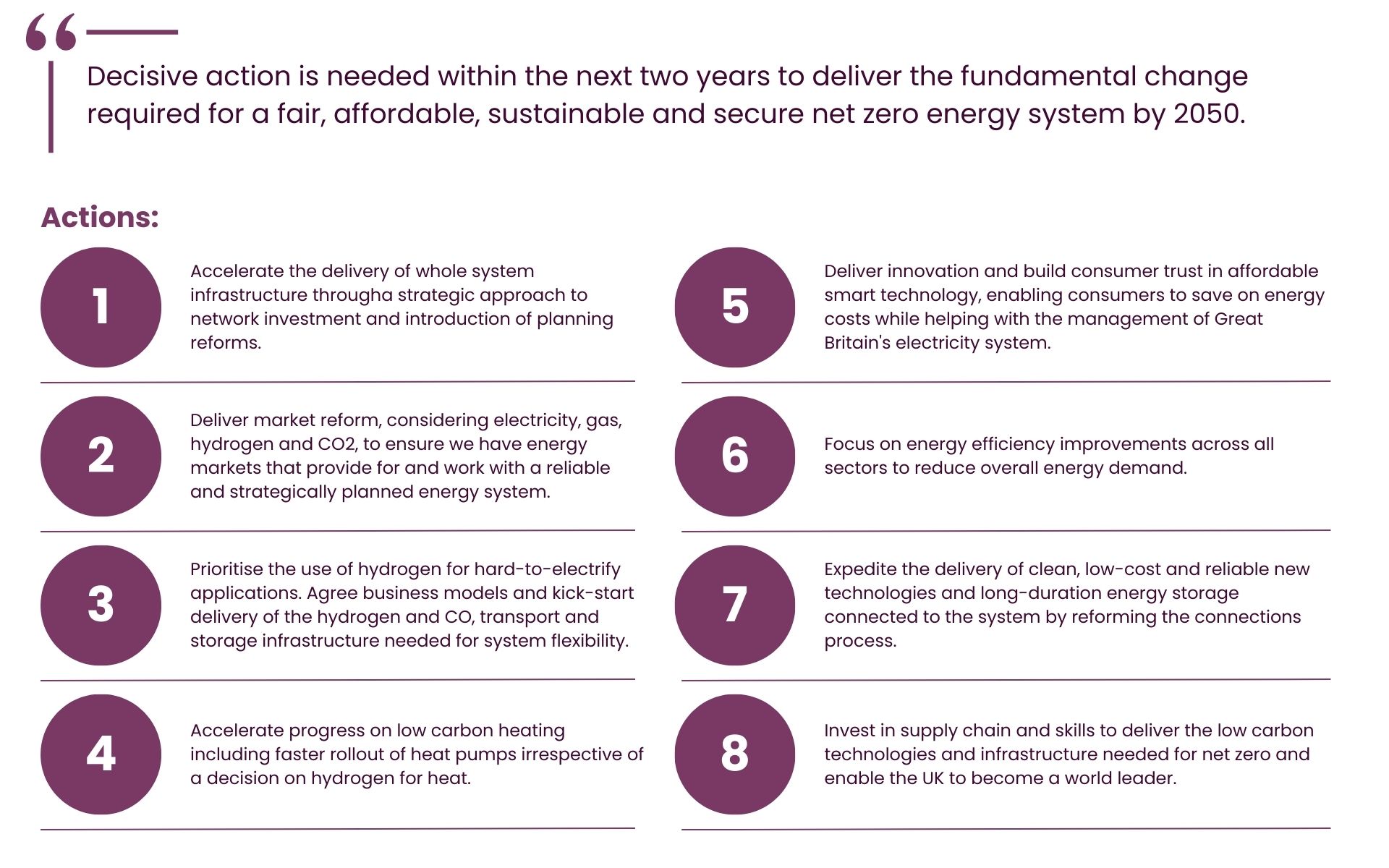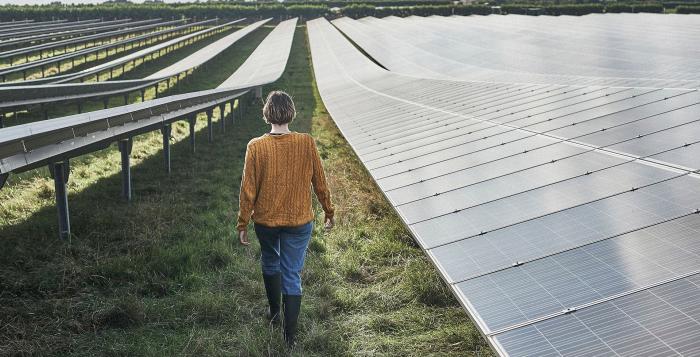
Future Energy Scenarios (FES)
Future Energy Scenarios (FES) 2024: NESO Pathways to Net Zero represent different, credible ways to decarbonise our energy system as we strive towards the 2050 target.
We’re less than 30 years away from the Net Zero deadline, which isn’t long when you consider investment cycles for gas networks, electricity transmission lines and domestic heating systems.
FES has an important role to play in stimulating debate and helping to shape the energy system of the future.

Summary of Stakeholder engagement FES 2025: NESO Pathways to Net Zero
This document provides information on our engagement activities that have taken place for FES 2025. We have shared summaries of the feedback that we have received from stakeholders and how we are addressing this for our 2025 report. FES 2025: NESO Pathways to Net Zero will be published summer 2025.

Future Energy Scenarios: Pathways to Net Zero 2025 Methodology
This document sets out the purpose of Future Energy Scenarios (FES), considering how we assess and develop credible routes to net zero through extensive analysis, research and stakeholder engagement. It also outlines the key principles in our whole system modelling approach and our processes concerning data transparency, governance and stakeholder engagement.
FES 2024 Chapters
The key insight, slides and webinar recordings are now in the tabs below. The full FES 2024 document is available to download here.

FES 2024: Executive introduction
The evolving dynamics of the energy system call for decisive action within the next two years to deliver the fundamental changes required to achieve a fair, affordable, sustainable and secure clean energy system by 2050. This means we must prioritise steps that will enable the delivery of cleaner, cheaper energy generation whilst ensuring a resilient system that delivers security of supply for consumers.
Decarbonisation of the energy system is the challenge of our generation. In recognition of the expansive industry transformation required to Great Britain’s energy network planning, this year’s Future Energy Scenarios (FES) framework has evolved from ‘scenarios’ to ‘pathways’ to explore narrower ranges and strategic, credible choices to propel us on the route to decarbonisation. This transition has also been reflected in our new publication name - Future Energy Scenarios: NESO Pathways to Net Zero.
FES creates the foundation upon which our future network investment plans will be built. We look forward to working with industry, the Government, Ofgem and our stakeholders and customers as we transition to NESO and build upon our analysis and insights to deliver on our critical role for society and the economy.
FES changes and pathway modelling
During this webinar we take you through the new framework and pathways for 2024, key changes from FES 2023, and modelling assumptions.
Key Message and Actions

Introduction
Great Britain has made significant progress in reducing carbon emissions. Since 1990, territorial greenhouse gas (GHG) emissions have halved, with renewable energy now accounting for more than 40% of our electricity mix. However, progress must now be accelerated.
Key insights and actions
Carbon budgets
- The UK has met the first three carbon budgets and is currently in the Fourth Carbon Budget period. The Sixth Carbon Budget (2033-2037) will be the first net zero compliant carbon budget.
- Decisive action is needed to increase the pace of decarbonisation across all sectors in line with the Sixth Carbon Budget. Our pathways require negative emissions technologies, despite the rapid and heavy decarbonisation modelled. These must be used to offset emissions in sectors that are hard to decarbonise.
Demand reduction
- Demand reduction measures include energy efficiency improvements and changes in consumer behaviour. These measures reduce net emissions, as less energy input is needed to meet demand.
- Shifting demand away from peak times can reduce emissions by avoiding additional high carbon generation.
Low carbon energy production
- A decarbonised power sector represents a critical milestone in the decarbonisation of the whole energy system. It can enable full decarbonisation of sectors such as transport and heat and can also hold the key to unlocking other energy vectors, such as hydrogen production.
- Our pathway modelling considers net zero to be the point at which emissions to atmosphere are fewer than emissions removed. Low levels of unabated gas generation (up to 5%) are compatible with a net zero power system alongside BECCS.
- It is possible to go further and faster in the decarbonisation of Great Britain's power sector.
Low carbon flexibility
- We need low carbon flexibility to operate a net zero energy system. This means switching from unabated gas to low carbon fuels and technologies.
- This, alongside electricity, CO2 and hydrogen storage, can help reduce emissions.
Fuel switching
- All net zero pathways require fuel switching from carbon intensive fuels to low carbon alternatives. This is particularly important for decarbonising heat and transport.
- Electrification is an important fuel switching option across all sectors, as is the production of hydrogen with electrolysis.
- Fuel switching will come with different challenges and opportunities in each sector, including the technological readiness of options, the rate at which they can be installed and the wider system benefits and trade-offs.
Carbon capture and storage capacity
- All net zero pathways require the development of carbon capture and storage (CCS) capacity.
- CCS is used across the decarbonisation of power (low carbon dispatchable power), industry, hydrogen production (gas reformation) and negative emissions technologies.
- The broad range of sector use for CCS networks will bring deployment challenges as different
- sectors begin to make use of these networks in different locations, at different times and to store
- different relative amounts of CO2.
Carbon removals
- Negative emissions technologies (NETs) are essential across all our net zero pathways. These are not used instead of other credible decarbonisation approaches. The deployment of NETs requires CCS pipeline capacity.
- Further demonstration of NETs is required to prove commercial readiness. Robust emissions accounting standards are also needed to ensure both investor and public confidence.
Introduction
Consumers are the heart of our energy system and the transition to clean energy sources must be fair and affordable for all.
This will require engagement in low carbon technology adoption and supporting consumers to help them get the most from their household energy efficiency measures.
Download Energy consumer and demand side flexibility webinar slides
Routes to net zero
Transport
- All pathways follow the Zero Emissions Vehicle (ZEV) mandate for electric car and van uptakes. Similar policies are needed for other vehicle sectors, as this provides a clear strategic route to net zero.
- There is a need to build consumer trust in smart chargers to allow users to realise cost savings while helping manage the electricity system.
- More investment is needed in public charge points to keep pace with electric vehicle uptake, targeting on route rapid chargers and competitive off-peak charging for consumers without home chargers.
Residential
- Market-wide-Half-hourly-settlement (MHHS) is needed to facilitate widespread adoption of time-of-use tariffs and demand side flexibility.
- Improved insulation measures are required in all pathways regardless of the heating technology, from aiding heat pump installation to reducing bills for hydrogen heat pumps with higher running costs.
- Even with support for hydrogen for heat in 2026, heat pump and district heating need to be accelerated to meet the Sixth Carbon Budget in the mid-2030s.
Industrial and Commercial
- Hydrogen use should be prioritised for hard-to-electrify sectors, including high temperature and combustible industrial applications.
- A clear, comprehensive carbon accounting policy, including a carbon border adjustment mechanism, is required to drive adoption of low carbon fuels.
Introduction
The energy system is undergoing rapid transformation. At the heart of this lies strategic coordination and whole system thinking across sectors, vectors and regions.
Decarbonisation of the power sector will mark a critical milestone in our journey to become net zero by 2050. One of the crucial first steps towards this will be establishing the infrastructure needed across Great Britain for all low carbon fuels to work together, with strategic development of energy networks, markets and technologies. Reforms to planning, markets and connections must now continue at pace, and this will rely on investment in supply chains and skills.
Download Energy system and supply side flexibility webinar slides
Key insights and actions
Electricity supply
- Generation capacity is expected to increase rapidly across all our pathways to meet increased demand from electrification of heat and transport.
- Most of this generation capacity will be weather dependent. Investment in renewable energy supply chains, market reform and improvements to the planning and connections processes could unlock huge opportunities around the delivery of renewable energy in Great Britain.
- Our pathways also show varying levels of nuclear, bioenergy with carbon capture and storage (BECCS), low carbon dispatchable power, interconnected flows and electricity storage.
Natural gas supply
- Natural gas plays a crucial role in meeting Great Britain’s energy demands. It will have an evolving role to play by 2050, coupled with carbon capture and storage for power and producing hydrogen.
- The role of natural gas combined with CCS in 2050 means that both gas and hydrogen infrastructure will be required. Any conversion of infrastructure to hydrogen must consider this. The ongoing costs associated with lower utilisation of assets alongside security of supply must also be considered.
Hydrogen supply
- Great Britain has the potential to become a world leader in the production of low carbon hydrogen. While there is already an established global hydrogen supply chain, this must now transition to low carbon production methods and must be substantially scaled up.
- The whole system benefits of hydrogen can only be realised through investment in hydrogen transport networks and storage. Prioritisation of the use of hydrogen for hard-to-electrify applications is needed.
- Clarity is needed on how hydrogen pipeline networks will be developed and how existing gas infrastructure will be repurposed.
Bioenergy supply
- Bioenergy can play an important role in the decarbonisation of all sectors of the economy but, as sustainable resources are limited, end uses of bioenergy must be prioritised where they can offer the biggest whole system benefits.
- Robust sustainability criteria are essential in ensuring maximum contribution to net zero from bioenergy, which is easier to assess for domestic supply chains. Reduced reliance on imports also reduces scope three emissions and strengthens security of supply.
- BECCS technologies could act as a source of net negative emissions. If the biomass value chain is sustainable, bioenergy could have an important role to play in the future energy system in this area.
Supply-side flexibility
- Increased levels of renewables will also need increased levels of flexibility. Our pathways demonstrate the importance of the interactions between low carbon fuels and technologies, alongside hydrogen and electricity storage, interconnectors and demand side flexibility to deliver a balanced system.
- Accelerating the development of hydrogen and CO2 storage facilities is required for security of supply. The timescales of developing large-scale hydrogen storage projects creates the risk of delays in the hydrogen value chain to develop production facilities, build transportation networks or switch fuels.
- Policy support for energy storage is essential to help bring forward the investment needed for long-duration energy storage. With the retirement or conversion of unabated gas plants post-2030, delivering the levels of energy storage and low carbon dispatchable power needed for security of supply will be essential.
FES 2024
FES: ESO Pathways to Net Zero 2024
The Future Energy Scenarios publication presents a number of strategic and credible energy futures to support Great Britain’s decarbonisation journey to net zero.
FES: Pathways at a Glance
For faster reading, download our FES summary document, which highlights the key headlines and statistics from the full publication.
FES 2024 Data workbook
All the graphs, charts and supporting data published in FES 2024 from our modelling. If using Microsoft Edge, you will need to download the file rather than view online.
Full suite of FES 2024 documents
Download our latest FES 2024 document suite and check out the archive of older FES documents.













